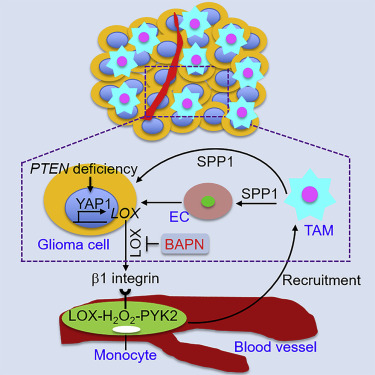Glioblastoma Multiforme (GBM) is one of the most lethal cancers with a median survival of 15 months despite surgery, radiation, and chemotherapy. Hence there is a desperate need for new treatments. One strategy involves targeting both glioblastoma cells and other immune cells that interact with the tumor. These immune cells known as macrophages have been shown to promote and sustain the growth of glioblastoma. It also turns out that glioblastoma cells have the ability to attract macrophages that ultimately sustain the growth of cancer. Hence identifying a common pathway or target that simultaneously promote tumors growth and also attract macrophages could pave the way for new therapies for GBM.

A group of researchers at the MD Anderson Cancer Center have found such a common pathway. A third of glioblastomas have a loss of function of a tumor suppressor gene (PTEN). Interestingly, it appears PTEN loss promotes both cancer cell growth and macrophage attraction. In animal models of glioblastoma, the researchers were able to identify a key signaling pathway in glioblastoma cells with PTEN loss they could be blocked to prevent macrophage recruitment into the tumor microenvironment and tumor growth.
“We’ve identified a symbiotic circuit that is activated in PTEN-deficient glioblastoma which creates a mutually supportive relationship between the cancer cell and macrophages that come into the tumor microenvironment and provide growth factor support for the tumor.
Ronald DePinho, MD & Professor of Cancer Biology at MD Anderson Cancer Center
In their research, “Symbiotic Macrophage-Glioma Cell Interactions Reveal Synthetic Lethality in PTEN-Null Glioma,” the team at MD Anderson Cancer Center, summarized their findings as follows:
- The LOX and SPP1 are the new targets for the PTEN-deficient Glioblastoma.
- Blocking either LOX or SSP1 could be beneficial in glioblastomas with PTEN loss.
While the above findings are exciting, additional preclinical studies are necessary in order to translate these findings to patients with Glioblastoma. Also, noteworthy is that these findings are only relevant for tumors with PTEN-loss.
